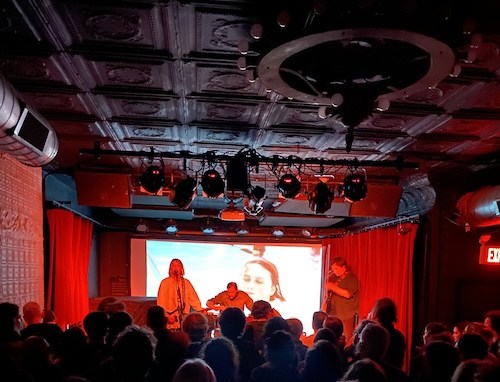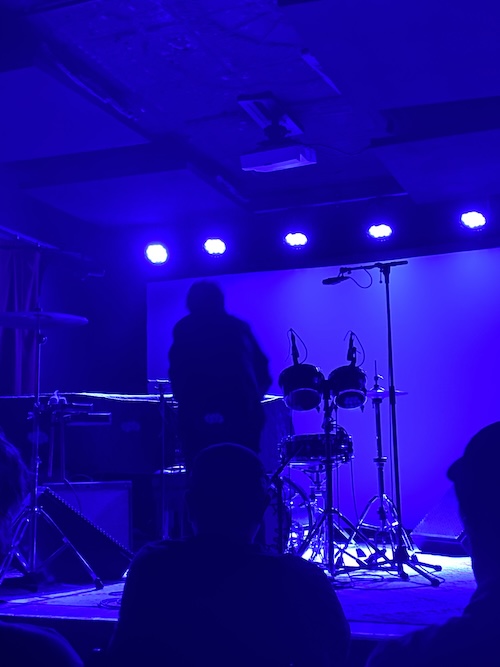Philadelphia’s avant-garde music scene has a loyal ally in Solar Myth and its Ars Nova Workshop promoters, who put together a 2025 show calendar (celebrating Ars Nova’s 25th anniversary) as jam-packed as it is dazzlingly comprehensive. (What’s up with Philly experimental bookers going over the top… have you seen the last couple of Making Time lineups???) All the “big” names of the experimental underground seem to make it a point to swing through Solar Myth nowadays – I’m pretty sure Marshall Allen has a private bedroom suite upstairs – and as I live a mere ten-minute walk away from the club (and a pleasant one at that), the only thing stopping me from attending on a weekly basis is the average $40+ ticket price. On back to back nights in early May, I splurged on incomparable noise-guitar duo Body/Head and multi-faceted virtuoso percussionist Valentina Magaletti.
Night one– Prompt to the minute, video curator 1-800-HOT-DUCK aka Chrissy Marie Jones opened with a half-hour edited montage at 8:00 PM, the footage true to her indispensable Instagram account (which is, easy enough, @1800hotduck). Clips were plucked from a variety of odd and off-the-beaten-path sources like public-access comedy, nihilistic underground art film, fetish clips, funny news reports and even an incredible Johanna Went music video, which reminded me to pull out her LP again soon. Though the typical Sonic Youth-enthusiast audience seems to somehow maintain an average height of six feet, I’m on the taller end of the spectrum and was lucky enough to view a good 70-80% of the projection screen broadcast in front of the standing-room-only crowd. Not everyone could say the same, however, so I hope they found their way to her Instagram page, or picked up a VHS at the merch table.
The crowd thickened in the interim between 1-800-HOT-DUCK and Body/Head, and I maintained my spot towards the center-back as well, a glass of rosé steadily warming in my hands. As luck would have it, Aaron Dilloway appeared on stage first, setting up one of his reel-to-reels, an unannounced guest added to the advertised Body/Head duo of Kim Gordon and Bill Nace. Fans will of course recognize that Body/Dilloway/Head released an album on Three Lobed back in 2021 – I confirmed that this was only their second time performing live as a trio. I didn’t purchase my ticket with the expectation of witnessing faithful renditions of my favorite Body/Head “songs”, and I’d assume the same went for the rest of the audience, so Dilloway’s addition was a welcomed surprise.

The set, consisting of a single piece that neared an hour, opened with one of Dilloway’s tape loops, a soft cyclical pattering as Gordon and Nace assembled themselves. Unhurried yet focused, the two guitarists linked into a harmonic web early in the set, a loosely psychedelic moment of beauty that I hadn’t anticipated. I was prepared for dual cascades of frothy feedback to attack my senses but the set lacked much in the way of outward aggression – another nice surprise. Even Dilloway, celebrated for his uncontrollably spastic physical performances, barely twitched in place. More time was spent in transitional phases than any sort of locked-in mode, with melancholic or buzzing motifs reacting to the patterns and varying intensities of Dilloway’s tape rig. Gordon would crouch down for minutes at a time, hidden by the crowd’s front row while presumably tinkering with her various effects, leaving Dilloway concentrating hard at his desk and Nace the energetic cornerstone of the trio, steering his guitar from an arrangement of angles and applying varying degrees of pressure, as likely to furiously strum the strings at the bridge of his instrument as grab the body of the guitar with two hands and shake as if he intended to pour martinis from it. Gordon sang infrequently, and when she did, the stark body of her voice took over – she wasn’t mixed any louder than her fellow performers, but her bassy frequency and unblinking delivery commanded our full attention, even as her words were affected enough as to remain inscrutable. Her final vocals were two full-bodied, Junko-esque screams, a pair of blood-curdlers that would normally communicate a lack of control, but even those felt impartial and constrained in her hands, one of the many sonic implements she’s spent decades accumulating. After navigating minutes of blissfully abstracted terrains, Dilloway and Nace eventually opened their eyes, looking like graduates of rival vo-tech schools in their navy-blue and army-green button-ups; Gordon shifted her gaze away from the middle-distance to acknowledge her fellow players for the first time, and as easily as the abstract and distant storm-clouds of their performance rolled in, their set concluded.
Night two– For as much as I enjoy the claustrophobic thrill of smushing myself into a packed room of bodies being blasted by loud music, I was relieved to note that Valentina Magaletti’s performance was billed as a seated show. Ars Nova takes care right down to the smallest detail, so these folded chairs weren’t standard issue Home Depot cheapos – they offered some padded support that only twenty-somethings would take for granted. (If anyone in attendance was in their twenties, I didn’t clock them – it felt like a safe space for the forty-and-up crowd.)

As soon as the house lights dimmed, Valentina Magaletti hopped onto the stage and crawled towards a small assortment of hand cymbals, wood blocks and resonant metal pieces. On her hands and knees, and fully enveloped in the array of pieces before her, Magaletti displayed the posture of a curious child deep in the throes of Lego. She clattered, clacked and popped the implements in front of her, all of which were run through actively-evolving forms of echo and reverb; the sound of a shaker might reproduce its own backwards mirror image, the smack of a drumstick on muted metal tumbled into cavernous echo. It was a small highlight of her set for me, the sheer incomprehensibility of how and why the sounds were mutating in real-time. The dim lighting and her huddled position obscured any chance I had of gaining answers to my questions, but that was a good part of the fun – I had no choice but to sit back and allow myself to be dazzled.
While still on the floor, Magaletti began to engage with the expensive-looking trap kit (the kick head adorned with a box-fresh Ars Nova Workshop logo) from the outside in. Maneuvering her way around the kit, she rose up and proceeded to tear it a new one, hustling through the swirl of influences that echo her recorded and collaborative material: jazz fluidity, airtight breakbeats, studied funkiness and playful exploration. She let out a loud cackle, and then proceeded to shout “hit / after hit / after hit / after hit” with each subsequent, uhh, hit, maybe a baker’s dozen she deemed worthy to describe out-loud to us. The set then led her to the other arranged gear on stage, including multiple tuned wood blocks, various toms and a brief tryst with a vibraphone. Throughout, additional backing tracks were piped through the PA, a variety of sounds ranging from steady rhythm tracks to more obscure sounds I’d associate with chains dragged across a table or idling dirt-bike engines. The backing tracks provided a bit of guidance, pushing her into different rhythmic conversations (and percussive stations). I’m of two minds with this: on one hand, it sounded dope as hell and her choice of backing sounds was inspired, but on the other, I would’ve been perfectly content for my ears to only hear the sounds that Magaletti cooked up live in front of me – if that meant the occasional silence or awkward moment, so be it. It’s clear to me that pre-recorded music in a live setting has become the norm, no matter if you’re a kvlt power-metal band or a fashion-forward cold-wave duo or a global pop-star, but its all-encompassing infiltration doesn’t mean I have to uncritically embrace it. Or at least, I can regret for Milli Vanilli’s sake that they were born two generations early. I could also say “Han Bennink wouldn’t need a backing track”, but I’m sure if he was here right now and I asked him, he’d be totally down to play with one and see what might happen. Maybe I need to loosen up and embrace a little technology once in a while… or not.
The best part of the set, in my estimation, came about forty minutes in, when a young woman ran up to the stage, hopped on, and started going buck-wild on the floor cymbals as Magaletti hammered away at the kit. I could feel the audience tense up around me for a good four or five seconds, all sharing my same confusion – was this person invited, or are the bum-rushing the show? – but as Magaletti seemed entirely unperturbed, we relaxed and settled into the added cacophony of this unknown guest’s rapid-fire clanging. After a good five minutes, the guest hopped back off, and Magaletti settled us back on solid ground with some soothing tones and a slowed, conversational approach to her kit. The backing track provided a calming loop, appropriate for end-credits, Magaletti thanked “Jessica”, and the lights came up. Back to the bar for a drink with Chris Forsyth, who was in attendance at both gigs as well, it turns out. Hell, he’s probably back at Solar Myth right now, and I wish I was too.

